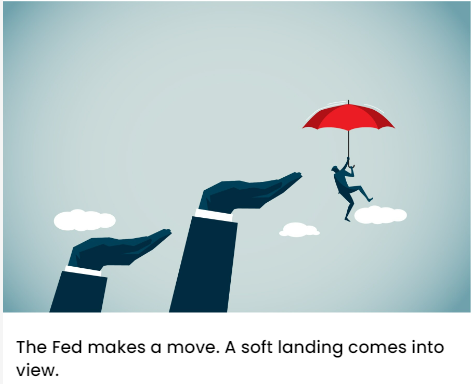CoStar Economy: The Fed makes a move. A soft landing comes into view. I
CoStar Economy: The Fed makes a move. A soft landing comes into view.

The Federal Reserve's policymaking committee ended its eight-meeting pause last week and finally cut its target short-term interest rate, choosing a 50-basis-point cut.
The much-anticipated rate cut turned out to be bigger than many analysts were expecting, although views started changing as the time of the decision’s release inched forward. The move brought the target federal funds rate to between 4.75% and 5%, a level last seen in March 2023 when the Fed was still raising rates.
Historically, a cut of this size usually signals fears of pending economic calamity, but Fed Chairman Jerome Powell called it simply “recalibrating.”
The committee has been focused on lowering inflation by keeping monetary policy restrictive as long as the labor market is resilient and adds jobs. Many market observers had hoped for a rate cut at the committee’s meeting in July, but the committee chose to make no changes.
However, days after that meeting, the employment report for July was released, showing much slower job growth than anticipated. August’s report was a bit better, but revisions of prior months’ gains were disappointing. Moreover, this followed another report showing that job gains over the 12 months ending in March 2024 were overestimated by 818,000, reducing the 12-month job gains by almost 30%.
Overall, the three-month moving average of job growth has slowed from 242,670 in January to 116,330 in August, a clear indication of a weakening labor market.
Powell signaled in his speech at the Jackson Hole Economic Symposium that as inflation was cooling, the committee was becoming more confident that it was moving in the right direction and could pivot to tending to its other mandate of maximum employment.
History has shown that labor markets can deteriorate quickly. The so-called Sahm Rule, which posits that a rise of 50 basis points in the three-month average of the unemployment rate over its 12-month low will be followed by a recession, has held for all recessions occurring in the last 60 years. The rule was again triggered in July, yet job layoffs remain muted . The recent rise in the unemployment rate has been attributed to an increase in the labor supply rather than an increase in the number of unemployed workers.
Inflation has subsided from its highs reached in June 2022. The Federal Reserve’s preferred measure of inflation, the core personal consumption expenditures (PCE) price index, which excludes the volatile categories of food and energy, was 2.5% in July, its latest reading. Figures for August are set to be released later this week.
Inflation can still bubble higher. Many have noted several inflationary impulses present in the economy today, including the deglobalization of supply chains and the transition to a net-zero carbon emissions economy, two structural changes that are likely to raise producer costs. Moreover, the remaining investment related to the CHIPS and Science Act and the Inflation Reduction Act should boost competition (and therefore prices) for workers, capital and materials.
So far, though, the Federal Reserve expects inflation to recede and rate cuts to continue. The median expectation of committee members is an additional 50 basis points of cuts this year.
Policymakers plan to meet twice more this year: in November, days after the presidential election, and in December, a week before Christmas. They have penciled in an additional 100 basis points of cuts for 2025, ending that year with a policy rate of 3.25% to 3.5%, which might be close to its neutral rate, or the rate that neither stimulates nor constrains economic activity. This rate is not known precisely but is estimated to be around 2.75% or 3%, where the long-run projections of the committee lie.
Committee members released their updated projections for several other indicators, including their projections for 2027 for the first time. Committee members see steady economic growth for the next three years at 2%, slightly above the growth trend. They see the unemployment rate rising to 4.4% by the end of this year and next before falling to 4.2% by the end of 2027.
This implies that unemployment will rise again in the coming months, as the August employment report showed that the unemployment rate ticked lower to 4.2%. They see inflation as measured by the core PCE price index falling from 2.6% at the end of this year to 2%, their target rate, by the end of 2026.
Overall, today's indicators point to the trifecta of a soft landing: The economy remains relatively strong, inflation is cooling and the unemployment rate hovers near historic lows.
What we’re watching …
Two more employment reports for September and October arrive before the Fed’s next meeting. With the Fed’s focus now on the labor market and ensuring conditions don’t deteriorate, these reports are likely to be critical.
Further softening in job gains or rising unemployment rates are likely to motivate larger and faster rate cuts to prevent a labor market meltdown that would tip the economy into recession. So far, Powell has steered monetary policy carefully and cemented his reputation as a master central banker, a legacy he is sure to fight to retain.
CoStar Economy is produced this week by Christine Cooper, CoStar's managing director and chief U.S. economist.
Keller Williams Realty, Inc. is a real estate franchise company. Each Keller Williams office is independently owned and operated. Keller Williams Realty, Inc. is an Equal Opportunity Employer and supports the Fair Housing Act.
The Summit Group
KW Commercial MN
(A division of Keller Williams Integrity Realty - Saint Paul)
2660 Arthur St,
Roseville, MN 55113
Keller Williams Realty, Inc. is a real estate franchise company. Each Keller Williams office is independently owned and operated. Keller Williams Realty, Inc. is an Equal Opportunity Employer and supports the Fair Housing Act.
The Summit Group
Contact Us | 612.963.5147
KW Commercial MN
(A division of Keller Williams Integrity Realty - Saint Paul)
2660 Arthur St,
Roseville, MN 55113
Keller Williams Realty, Inc. is a real estate franchise company. Each Keller Williams office is independently owned and operated. Keller Williams Realty, Inc. is an Equal Opportunity Employer and supports the Fair Housing Act.
The Summit Group
KW Commercial MN
(A division of Keller Williams Integrity Realty - Saint Paul)
2660 Arthur St,
Roseville, MN 55113



